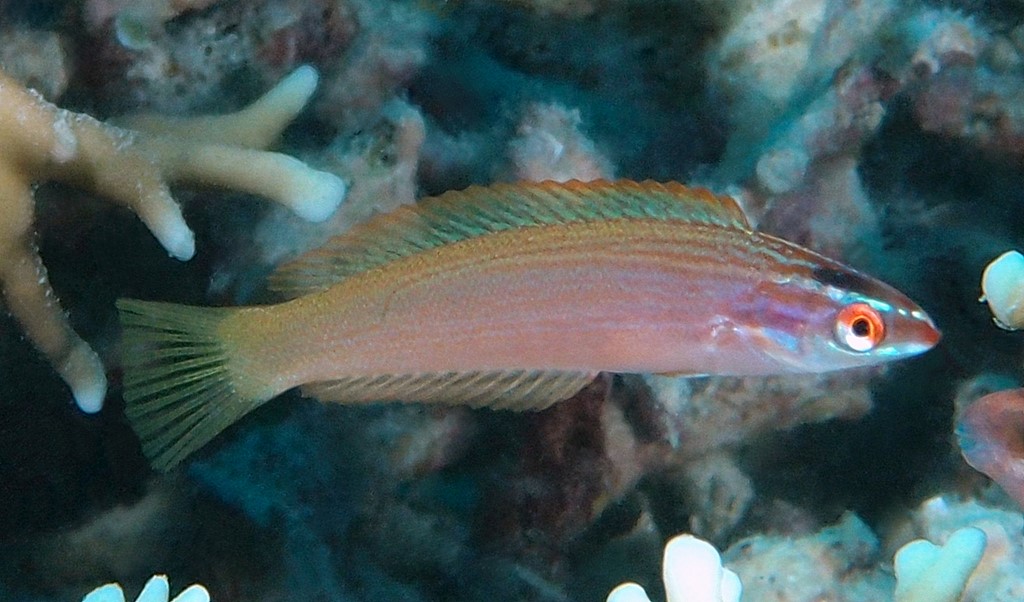PSEUDOCORIS YAMASHIROI - (SCHMIDT, 1931)
Actinopterygii (Gigaclass) > Actinopteri (Class) > Teleostei (Subclass) > Labriformes (Order) > Labroidei (Suborder) > Labridae (Family) > Pseudocoris (Genus)
Labre torpille Japonais, Japanese wrasse, Japanese torpedo wrasse, Pink wrasse, Redspot wrasse, Redthroat Rainbowfish, Yamashiro's wrasse, Yamashirobera, ヤマシロベラ, 擬盔魚, 棕红拟盔鱼,
Synonymes
Julis awayae (Schmidt, 1931)
Julis yamashiroi (Schmidt, 1931)
------------------------
Description
Dorsal spines (total): 9; Dorsal soft rays (total): 12; Anal spines: 3; Anal soft rays: 12; Pectoral fin rays: 13; Lateral line scales: 69-73; Head scaleless; A single pair of canine teeth anteriorly in jaws, the upper pair strongly curved laterally; Remaining teeth in jaws small; No canine at corner of mouth; Lower free margin of preopercle longer than upper margin; Body moderately elongate, the depth: 3.5-1.1 in Standard Length; First two dorsal spines close together, prolonged in males; Caudal fin slightly emarginate; Pelvic fins short: 2.2-2.7 in Head; First dorsal spin in males elongated. Max. length: 16.0 cm TL. Depth range: 5 - 30 m.
Color
Females are pinkish to pale purplish-grey with a silvery-white stripe above and below the eye, and a distinct red spot on the pectoral fin base.
Males are greenish-blue on the upper two-thirds of the body with a dense pattern of fine black spots and irregular vertical lines, a white belly, and dark outer caudal-fin rays making the tail appear deeply forked.
Etymology
Pseudocoris: from Greek, pseudes = false + from Greek, coris = summit, head. Although this genus may resemble Coris, such an appearance is false (according to Randall et al. 2015, Pseudocoris is an evolutionary offshoot of Coris adapted to feeding on zooplankton in the water column whereas Coris are benthic feeders on hard-shelled invertebrates).
yamashiroi: in honor of Mr. A. Yamashiro, professor of English in Naha, Japan, to whom Schmidt was “very much indebted for the success of [his] collecting work on the Okinawa Island” (Yamashiro apparently served as a guide and interpreter).
Original description: Julis yamashiroi Schmidt, 1931 - Type locality: Itoman, Okinawa Island, Ryukyu Islands, Japan.
Distribution
Indo-West Pacific: East Africa, Madagascar, western Mascarenes, Maldives and Chagos Archipelago, east to Marshall Islands and Samoa, north to Kagoshima Prefecture (southern Japan), south to Lord Howe Island, New Caledonia and Kermadec Islands.
Biology
Found in lagoon, channel and seaward reefs. Often on open sand flats with large remote bommies. Juveniles congregate on reefs feeding on mysids. Aggregates (with females outnumbering the males) along upper edges of coral slopes to feed on zooplankton. Forms a harem with a dominant male and a group of females. This species is collected for the aquarium trade.
Last update: 27, September 2024
Labre torpille Japonais, Japanese wrasse, Japanese torpedo wrasse, Pink wrasse, Redspot wrasse, Redthroat Rainbowfish, Yamashiro's wrasse, Yamashirobera, ヤマシロベラ, 擬盔魚, 棕红拟盔鱼,
Synonymes
Julis awayae (Schmidt, 1931)
Julis yamashiroi (Schmidt, 1931)
------------------------
Description
Dorsal spines (total): 9; Dorsal soft rays (total): 12; Anal spines: 3; Anal soft rays: 12; Pectoral fin rays: 13; Lateral line scales: 69-73; Head scaleless; A single pair of canine teeth anteriorly in jaws, the upper pair strongly curved laterally; Remaining teeth in jaws small; No canine at corner of mouth; Lower free margin of preopercle longer than upper margin; Body moderately elongate, the depth: 3.5-1.1 in Standard Length; First two dorsal spines close together, prolonged in males; Caudal fin slightly emarginate; Pelvic fins short: 2.2-2.7 in Head; First dorsal spin in males elongated. Max. length: 16.0 cm TL. Depth range: 5 - 30 m.
Color
Females are pinkish to pale purplish-grey with a silvery-white stripe above and below the eye, and a distinct red spot on the pectoral fin base.
Males are greenish-blue on the upper two-thirds of the body with a dense pattern of fine black spots and irregular vertical lines, a white belly, and dark outer caudal-fin rays making the tail appear deeply forked.
Etymology
Pseudocoris: from Greek, pseudes = false + from Greek, coris = summit, head. Although this genus may resemble Coris, such an appearance is false (according to Randall et al. 2015, Pseudocoris is an evolutionary offshoot of Coris adapted to feeding on zooplankton in the water column whereas Coris are benthic feeders on hard-shelled invertebrates).
yamashiroi: in honor of Mr. A. Yamashiro, professor of English in Naha, Japan, to whom Schmidt was “very much indebted for the success of [his] collecting work on the Okinawa Island” (Yamashiro apparently served as a guide and interpreter).
Original description: Julis yamashiroi Schmidt, 1931 - Type locality: Itoman, Okinawa Island, Ryukyu Islands, Japan.
Distribution
Indo-West Pacific: East Africa, Madagascar, western Mascarenes, Maldives and Chagos Archipelago, east to Marshall Islands and Samoa, north to Kagoshima Prefecture (southern Japan), south to Lord Howe Island, New Caledonia and Kermadec Islands.
Biology
Found in lagoon, channel and seaward reefs. Often on open sand flats with large remote bommies. Juveniles congregate on reefs feeding on mysids. Aggregates (with females outnumbering the males) along upper edges of coral slopes to feed on zooplankton. Forms a harem with a dominant male and a group of females. This species is collected for the aquarium trade.
Last update: 27, September 2024
